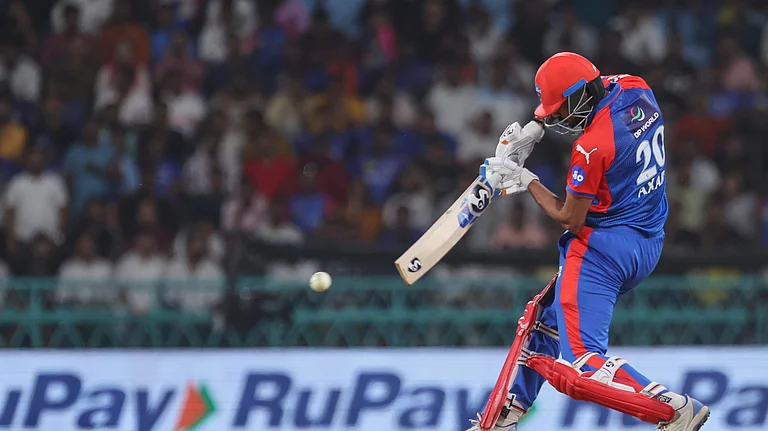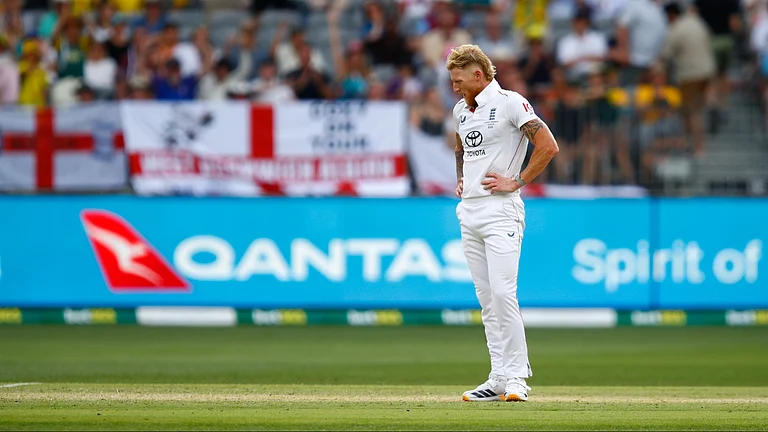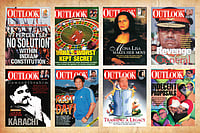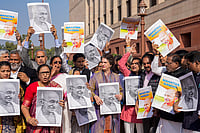SO you want to buy art? But art is about good taste. Not sure you have that? Well, buy that first. Buy the art later. But can you buy good taste? Might be in bad taste to say so, but, yes, you can. From taste sultants who will help you acquire that. like everything else it comes for a price.
Taste consultants: these self-styled thetes will first help you acquire the Attitude, next the right Art. For a commission that may range from 20 cent to 30 per cent of the value of 'product' acquired. Telephone, transport, facsimile charges extra, of course. These new tycoons of the trade, no less than a dozen in Bombay and Delhi alone, proliferated in the last decade: product and inevitable consequence of the resurgence in the Indian art market. Each one of them raking in the rupees, capitalising on what Kekoo Gandhi, proprietor, Bombay's Chemould Gallery, calls the "fashionable new trend of acquiring art".
Not fashion alone. Factored into the growth of the taste consultants were other causes. Explains Gandhi: "Banks, corporations want to start art collections. Their managers may not have the time or the taste to do so. That's where your art or 'taste' consultant, if you like, steps in." Not tycoons and trading houses alone. Today even nouveau riche novitiates are seeking out taste consultants to help them purchase art. "Poor darling greenhorns," sneers a wealthy Bombay industrialist's wife renowned for her painterly good taste about aesthetic arrivestes that periodically besiege her with kiskee painting loon yaar queries. "They have the greenbacks but how do I explain to them that art is not about cash but class, vision not vulgarity. I just refer them to a consultant for some aesthetic upgrading."
Housewives, saleswomen, painters,architects, art aficionados, sensing a great new business opportunity, have jumped enthusiastically into this business of "aesthetic upgradation". Making up in enthusiasm what they lack in education. The toast of the taste consultancy trade in Bombay include 'cultured' housewives like the architects, art aficionados, sensing a great new business opportunity, have jumped enthusiastically into this business of "aesthetic upgradation". Making up in enthusiasm what they lack in education. The toast of the taste consultancy trade in Bombay include 'cultured' housewives like the mother-daughter duo of Usha Mirchandani, 55, and Ranjana Mirchandani, 28, art consultants to the Deutsche Bank apart from innumerable sybarites. Both of them have been running their Fine Art Resource consultancy ("the only professional art consultancy in the country," they inform you) for the last seven years from their chic apartment gallery on fashionable Warden Road. There is the sister duo of Shanti Chopra, 56, and Kasturi Wadhwani, 54, who started Art Rhythms five years ago and with whom the Taj, Citibank, Bank of America and sundry private clients consult on their art purchases. Not queenbee housewives alone. In Bombay, artsies too have taken up the new trade. Like painter Bharti Kapadia, 48, who for the last 10 years has advised, among others, S.H. Daya, proprietor, Dawood Shoes, and Asha Sheth, proprietor of Great Eastern Shipping Company, on their art acquisitions. Taste consultants in Delhi tooare a mix of dabblers and dilettantes: Vandana Datta, 32, was a saleswoman before she turned aesthetic arbiter and floa-ted The Aesthete art consultancy three months ago; Siddharth Tagore, 38, now a gallery owner in both Calcutta and Delhi, was a Lintas Advertising man, 'client servicing' in Calcutta before he took to 'taste refurbishing' in Delhi.
Not love of art alone. It's love of lucre that lures new entrants to the taste trade. Says Tagore: "It's a business that requires no investment except in taste which you must have. You don't rent space to store or display. All you do is take the client to the artist's studio. If the deal is clinched collect your commission, 10 per cent each from buyer and seller in my case, and go home." In a year of operation in Delhi, Tagore has gone home with about Rs 1 lakh in commissions. "It's a clean business," he declares.
And a lucrative one too. Precise figures are hard to come by but industry sources aver the Mirchandanis' Fine Art Resource has augmented its resource considerably over the last five years through its association with the Deutsche Bank. In the last five years they've brokered the purchase of works by eminent Indian painters like M.F. Husain, S.H. Raza, Atul Dodiya, Chittro-vanu Mazumdar, Ram Kumar, Jogen Cho-wdhury, Akbar Padamsee among others for the Deutsche Bank collection. Conservative estimated value of the collection: Rs 1 crore. Commission earned: 20 per cent, or Rs 20 lakh. And Deutsche Bank is just one of their clients. It seems to be boomtime for almost all players in the taste trade. Chopra and Wadhwani of Art Rhythms, who count Elbee Couriers, Taj Hotels, Bank Of America among their clients, admit grudgingly ("fig-ures are always a sensitive issue," quips Chopra) to a turnover of Rs 15 lakh in five years. Business is brisk. And growing. "Increasingly our regular clients are corporate executives. They are interested, aware, keen to buy art rather than anything else. Sometimes they cannot pay in one go, so we offer them easy payment terms," reveals Chopra. Kapadia, in the business sporadically for the last 10 years, has pursued a full-time career as a painter even as she has netted commissions worth approximately Rs 5 lakh acquiring works for the Daya collection as also for the tankers and offices of the Great Eastern Shipping Company.
As always, it's the small success story that is most revealing. Datta, one-time sales lady and coordinator at Jharokha Art Gallery at Delhi's Hauz Khas Village, floated The Aesthete three months ago. Qualifications for the job: two short art appreciation courses at Delhi's National Museum and the National Gallery of Modern Art. Total investment in the business: Rs 2,500 per month in rent apart from telephone and transport. Turnover in just two months ofoperation: Rs 1,50,000. Commission earned: 30 per cent, or Rs 45,000. "Considering I was making Rs 6,000 a month in my last job, this is a distinct improvement," she gurgles happily.
CLEARLY it's boomtime for the taste consultant. Datta sold 10 paintings in one day to a businessman aspiring toturn collector. "The key is sensible pricing," she reveals. "First-time buyers are intimidated if you mention steep price tags. Which is why I sell medium-priced painters like Niladri Paul, Vinod Sharma, Dharmendra Rathore, Shobha Broota." Kapadia adopts a similar approach: she sold C. Douglas, Palaniappan, Prabhakar Kolte, Prabhakar Barve when they were not names to reckon with. Tagore endorses the strategy: "A con-sultant is a young painter's best option because not many galleries would invest in time, catalogue and brochure expense on a younger painter as a consultant would Besides there are enough people vying to sell 'premium products'. "
The tycoons of the taste business stress that they serve a function. "As a painter bring a discriminating eye, lend authority to the client's purchase," says Kapadia. "We teach collectors not to buy so expensive that they can't resell later, build specialised collections, sort the chaff from the grain, invest in young artists who will not be here today, gone tomorrow," explains Tagore. He cites the instance of Aseem Pal whose 1992 exhibition in Delhi, praised by Husain, created waves in Delhi's art circuit. "But Aseem proved to be inconsistent. He dropped painting for a career in advertising. The value of his works bought by enthusiastic novices has dropped steeply since."
Gallery owners and painters are supportive of taste consultants "They are invaluable for people that have the impulse but not the education to buy art," declares Gandhi. Bombay-based painter Mehli Ghobai finds them to be an asset to the artistic community: "These people scour galleries, bring lesser known painters to the notice of buyers pressed for time." For him the long-term ben-efits are significant: "They help build the collector's help build the collector's eye. People who would initially veer towards the merely decorative would pick up a less accessible work because they have been taught to discern the cerebral from the simplistic."
Today, the catchword in this trade, as in any other, is diversification. Thus, Kapadia is charging Bombay's Lakeerein Gallery Rs 50,000 over six months to curate and organise shows: she's done four to date including the ongoing one on 100 years of Indian cinema. Tagore offers a gallery consultancy in Delhi to do the same apart from a resale advice service. Datta plans to turn adviser to a client buying works for a chain of schools he plans to open all over the country. At least, the business, if not the practice, of good taste is poised for growth.


























